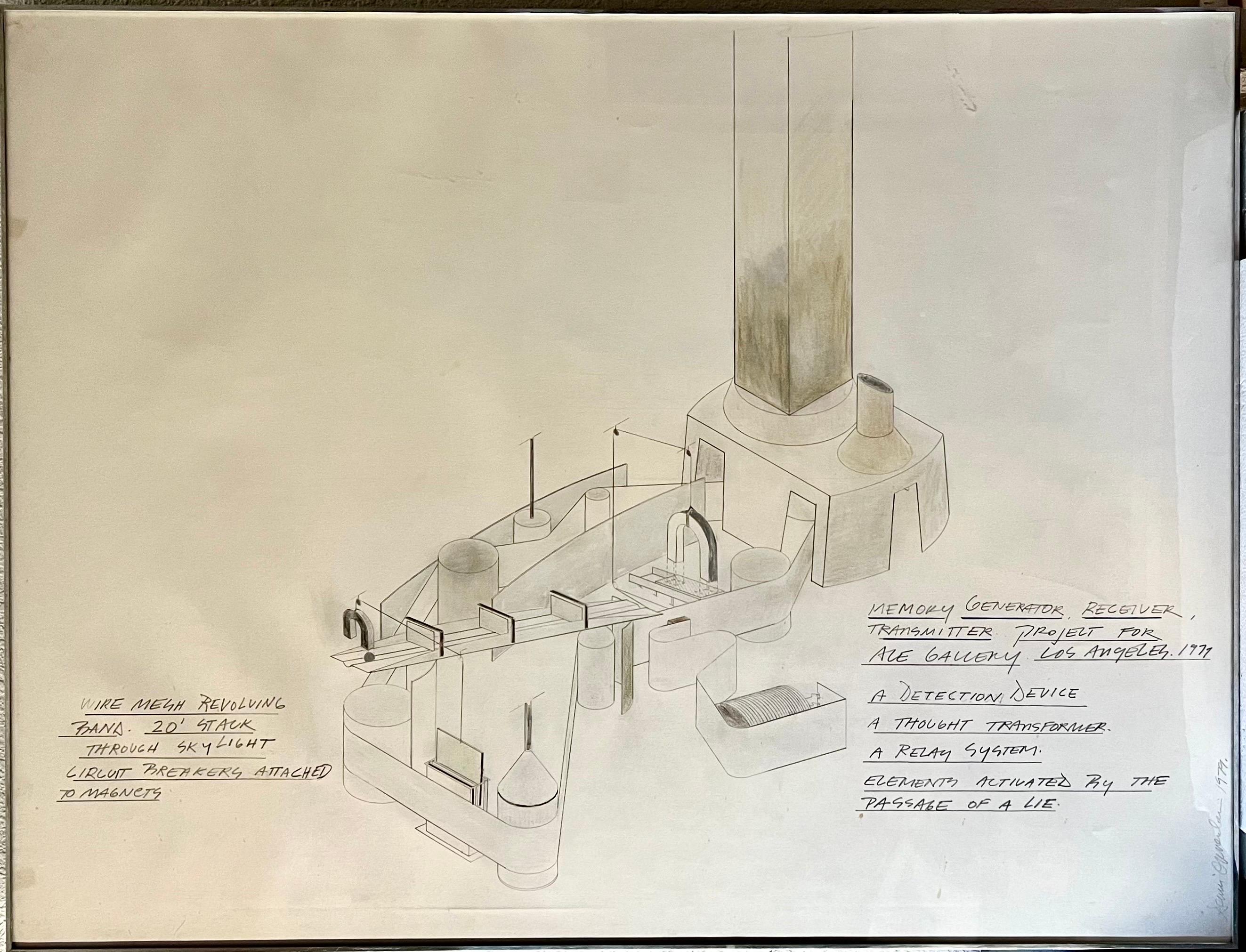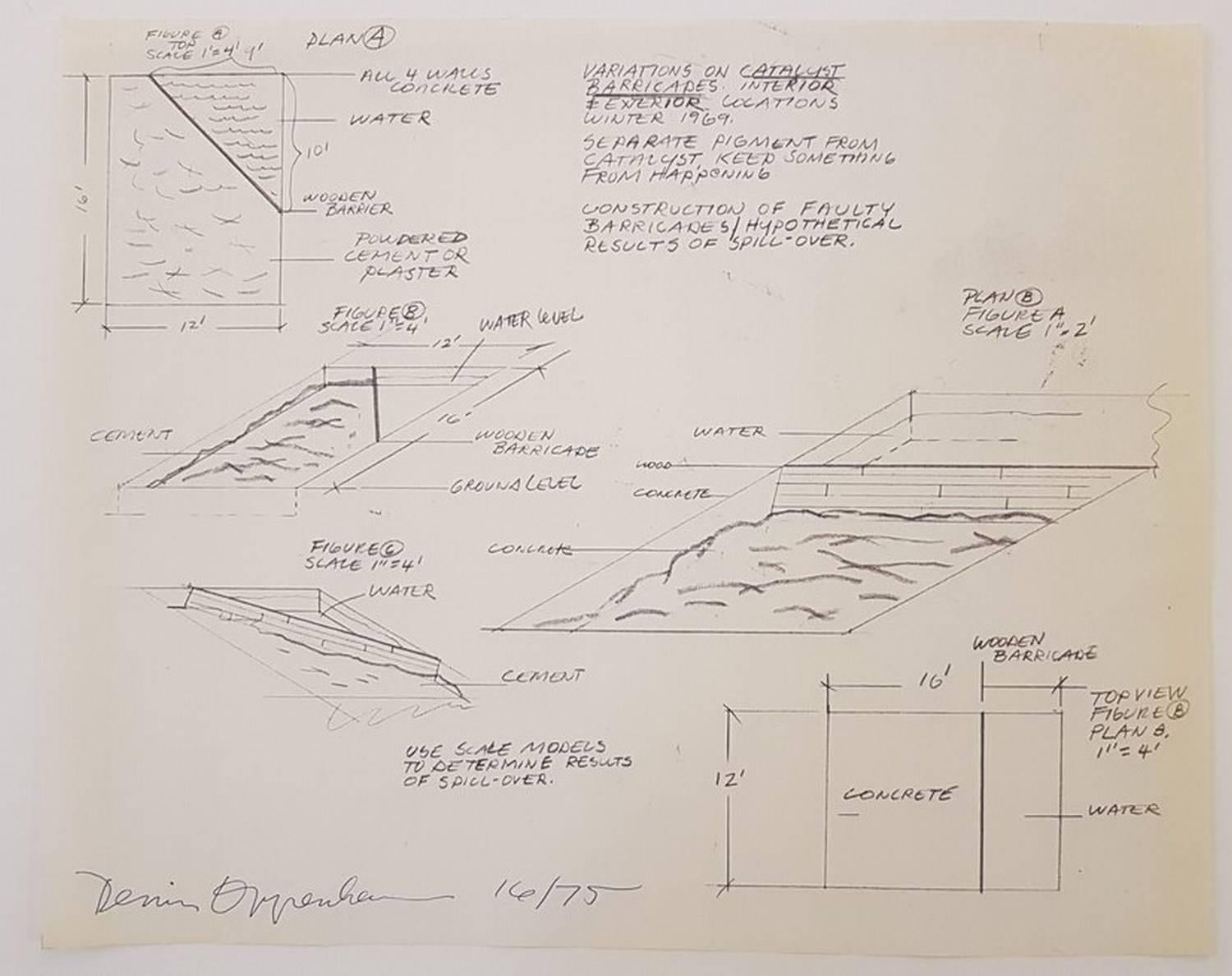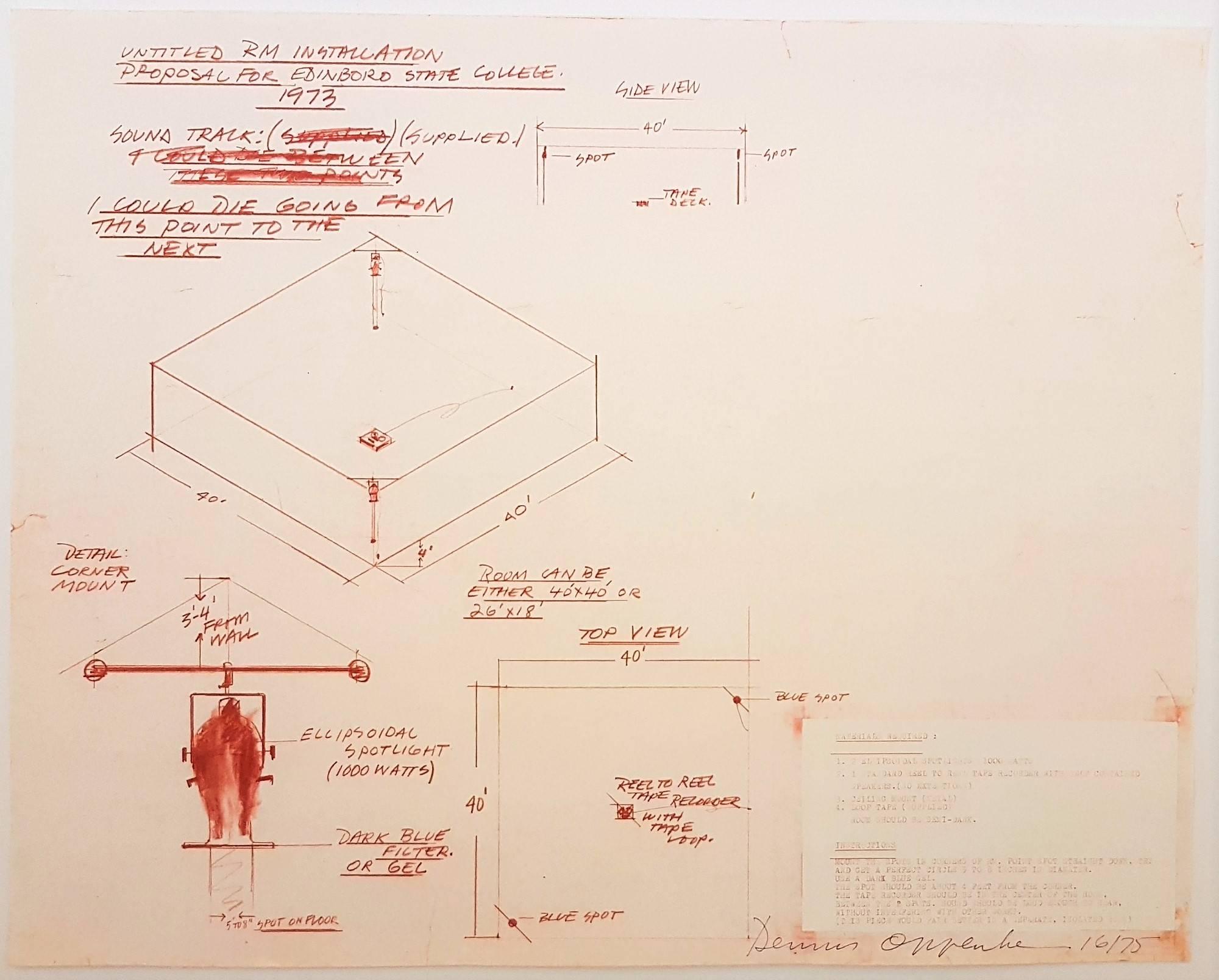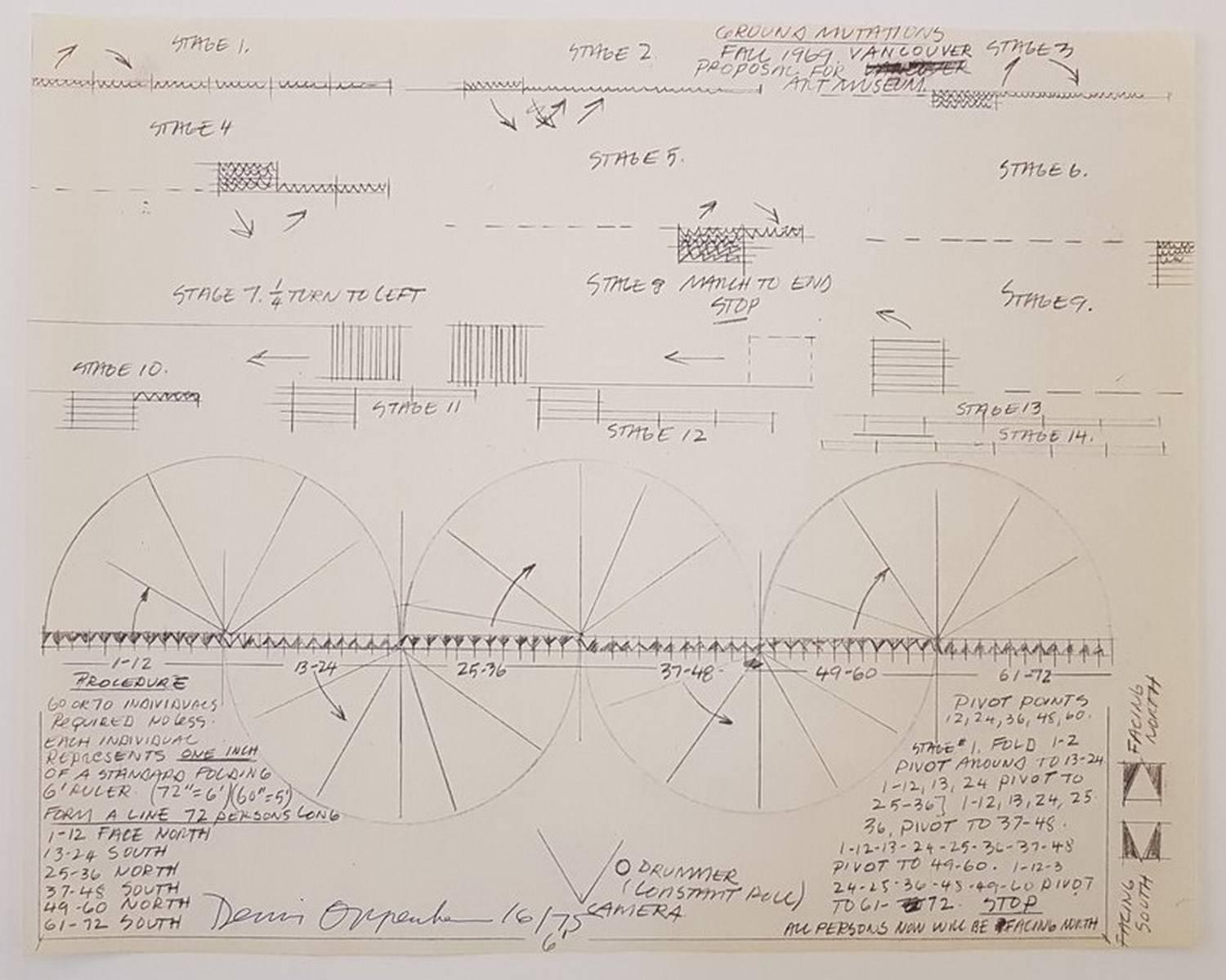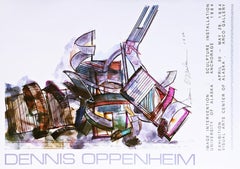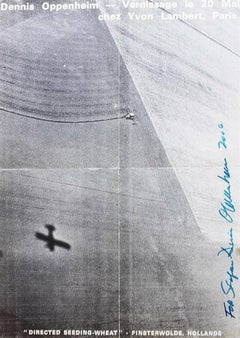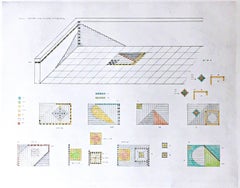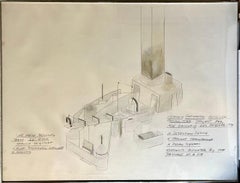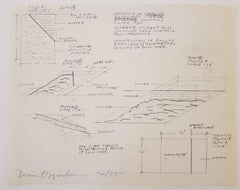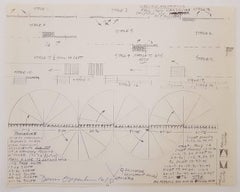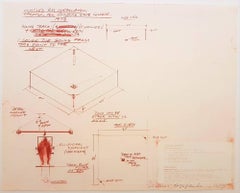Items Similar to A Device for Converting a Chilling Underground Wind into Memory Signed/N Print
Want more images or videos?
Request additional images or videos from the seller
1 of 9
Dennis OppenheimA Device for Converting a Chilling Underground Wind into Memory Signed/N Print1986
1986
$750
£582.93
€664.67
CA$1,076.06
A$1,171.32
CHF 619.22
MX$14,162.61
NOK 7,762.61
SEK 7,265.79
DKK 4,962.13
About the Item
Dennis Oppenheim
A Device for Converting a Chilling Underground Wind into Memory, 1986
Lithograph
Hand signed, numbered 3/100 and dated on lower front
38 1/5 × 50 inches
Unframed
Pencil signed and numbered; unframed. A terrific print for fans of this interesting conceptual art pioneer.
This large architectural lithograph by Dennis Oppenheim, depicting plans for a large conceptual art proposal, is hand signed, dated and numbered on the lower recto (front) from an edition of 100. The text at the bottom of the lithograph reads as follows:
"A device for converting a chilling underground wind into memory. Installation for Brule Gallery, Edinboro Pennsylvania. 13 ' x 50' x 50'. Three hardwood floor bellows suspended by 10" diameter steel springs bounded on two sides by a series of movable caster mounted panels constructed in steel and canvas. Immediately ahead is a 24 ' galvanized steel tunnel, capable of expanding and contracting hanging above this tunnel is a series of templates made of rubber and gasket material each template is pierced by small elliptical shapes. This entire unit is capable of entering the slits in the tunnel, and is controlled by a pulley system, counter weighted by a hanging basket of coal positioned on steel tracks and pulled back with rubber straps, and aimed into the tunnel and bellows. Crossing the track and also pulled back and aimed is the second raw material cart, which is equipped with grinding wheels. It's target is the multi-flued furnace twenty five feet away. "
- Creator:Dennis Oppenheim
- Creation Year:1986
- Dimensions:Height: 38.2 in (97.03 cm)Width: 50 in (127 cm)
- Medium:
- Movement & Style:
- Period:
- Condition:There is gentle handling and a small tear of several millimeters on the center margin edge which will frame out easily. Otherwise very good.
- Gallery Location:New York, NY
- Reference Number:1stDibs: LU1745215258242
About the Seller
5.0
Platinum Seller
Premium sellers with a 4.7+ rating and 24-hour response times
Established in 2007
1stDibs seller since 2022
458 sales on 1stDibs
Typical response time: 2 hours
- ShippingRetrieving quote...Shipping from: New York, NY
- Return Policy
Authenticity Guarantee
In the unlikely event there’s an issue with an item’s authenticity, contact us within 1 year for a full refund. DetailsMoney-Back Guarantee
If your item is not as described, is damaged in transit, or does not arrive, contact us within 7 days for a full refund. Details24-Hour Cancellation
You have a 24-hour grace period in which to reconsider your purchase, with no questions asked.Vetted Professional Sellers
Our world-class sellers must adhere to strict standards for service and quality, maintaining the integrity of our listings.Price-Match Guarantee
If you find that a seller listed the same item for a lower price elsewhere, we’ll match it.Trusted Global Delivery
Our best-in-class carrier network provides specialized shipping options worldwide, including custom delivery.More From This Seller
View AllColor applications for Chandra signed limited edition print, conceptual sculptor
Located in New York, NY
Dennis Oppenheim
Color applications for Chandra (hand signed limited edition), 1977
Color lithograph and photo lithograph on wove paper
Signed and dated 1977 in graphite pencil on th...
Category
1970s Conceptual Animal Prints
Materials
Lithograph, Offset
Image Intervention project in Alaska poster (Hand Signed by Dennis Oppenheim)
Located in New York, NY
Dennis Oppenheim
Image Intervention (Hand Signed), 1984
Offset Lithograph (hand signed and dated by Dennis Oppenheim)
Hand signed and dated on the middle front
28 × 20 inches
Unframe...
Category
1980s Conceptual Figurative Prints
Materials
Ink, Lithograph, Offset
RARE Yvon Lambert Gallery mailer (Hand Signed and Addressed by Dennis Oppenheim)
By Dennis A. Oppenheim
Located in New York, NY
Dennis Oppenheim
Directed Seeding -Wheat, Historic Yvon Lambert Gallery Poster (Hand Signed and Addressed by Dennis Oppenheim), 1969
Offset lithograph poster. Hand signed, inscribed. Postmarked and addressed to Oppenheim's dealer, John Gibson
23 × 16 inches
Hand Signed and inscribed by Dennis Oppenheim lower right in blue marker in 2006, hand addressed by Dennis Oppenheim in 1969 in red marker
Unframed
This is an extremely uncommon vintage poster/mailer announcing the May 20th, 1969 opening reception (Vernissage) for the exhibition of works by American conceptual art pioneer Dennis Oppenheim at the Yvon Lambert Gallery in Paris. The poster is historic in that it was originally mailed to John Gibson, the East 67th Street dealer, who famously gave Dennis Oppenheim his first New York exhibition in 1968, and it is hand addressed to Gibson, bearing the original Paris, France postmark of 1969. It is, exceptionally, hand signed and dedicated by Dennis Oppenheim to a collector who acquired the poster from John Gibson's collection, and then secured Dennis Oppenheim's autograph in 2006, making this an especially valuable collectors item.
More information about the project from the Tate Gallery archives, which acquired the work:
This work brings together two interventions Oppenheim created on a field owned by farmer Albert Waalken in Finsterwolde, north-eastern Holland, in 1969. It comprises four distinct elements mounted on board: a colour photograph of a wheatfield being sowed by a tractor in parallel curving lines seen from high up; a negative image in black and white of a map of the area of Finsterwolde onto which two sections of text have been collaged; and two black and white aerial photographs of the same field being traversed by a tractor cutting an X into the wheat. The first two elements relate to the action Directed Seeding. For this the field was seeded according to a line plotted by following the road from the village of Finsterwolde, the location of the field, to Nieuweschans, another village where the farmer’s storage silo for wheat was located. Oppenheim reduced this curved line by a factor of six in order to direct the trajectory of seeding. The tractor then carved a series of curved parallel lines on the surface of the field as it dug up earth and scattered seed. From an aerial perspective the patterning of parallel lines may be viewed as a form of line drawing on the landscape. The precise location of the field and the silo are indicated on the map, showing the trajectory of the road. The two sections of text collaged onto the upper portion of the map briefly describe the two interventions. Explaining the action Cancelled Crop, the artist wrote:
In September the field was harvested in the form of an X. The grain was isolated in its raw state, further processing was withheld. This project poses an interaction upon media during the early stages of processing. Planting and cultivating my own material is like mining ones own pigment (for paint) – I can direct the later stages of development at will. In this case the material is planted and cultivated for the sole purpose of withholding it from a product-oriented system. Isolating this grain from further processing (production of food stuffs) becomes like stopping raw pigment from becoming an illusionistic force on canvas. The esthetic is in the raw material prior to refinement, and since no organization is imposed through refinement, the material’s destiny is bred with its origin.
(Quoted from artist’s statement in Tate acquisition file.)
Directed Seeding and Cancelled Crop are two separate works, brought together in several different versions of which Tate’s is one. The collage presents three ways in which human action may marks the land. For the first two, agricultural machinery is used to create straight lines, in the process of harvesting as in the X of Cancelled Crop, or curved lines, during the process of planting seed in the contours photographed for Directed Seeding. The map shows a third (and more ancient) way of marking the land, through the construction of roads. The use of the landscape – natural, industrial or urban – as a canvas on which to act is typical of Oppenheim’s work in the late 1960s and early 1970s. In a related action, Directed Harvest, 1966 (Tate T07590) and Directed Harvest 1968 (Kröller-Müller Museum, Otterlo, Netherlands), the artist caused a field to be harvested in linear patterns which he then had photographed in its progressive stages. In Reverse Processing: Cement Transplant, East River, NY, 1970, 1978 (Tate T07591) Oppenheim drew large crosses on the roofs of barges transporting raw cement that he found moored on the New York East River banks. All these works centre on process as an agent of change and utilise materials, elements and locations on which the artist can have no permanent claim, making them deliberately ephemeral. Such actions as seeding a crop and harvesting it several months later operate within time parameters dependent on the cycles of the seasons rather than the will of man, mixing human processes with those of nature. Oppenheim’s analogy between the prevention of a crop from entering the food chain and the halting of the expressive, ‘illusionistic’ force of paint deconstructs the sophisticated processes of art-making and the food industry to the elemental notion of making simple marks on the environment. In this way, the artist highlights contemporary man’s dependency on complex chains...
Category
1960s Conceptual Abstract Prints
Materials
Offset, Lithograph
Rare signed/n etching with hand coloring by renowned Minimalist sculptor Atelier
Located in New York, NY
Jackie Ferrara
Untitled, from the Atelier International Portfolio, 1986
Hand Colored Etching on paper with deckled edges. Publisher's and Printer's Blind Stamps. Hand Signed. Numbere...
Category
1980s Minimalist Abstract Prints
Materials
Pencil, Etching
Book: Selected Works 1967-90 And the Mind Grew Fingers (PLUS handwritten letter)
Located in New York, NY
Dennis Oppenheim
Dennis Oppenheim: Selected Works 1967-90 : And the Mind Grew Fingers (with handwritten signed letter laid in separately), 1992
Softback book with separate hand signe...
Category
1990s Conceptual More Art
Materials
Ink, Mixed Media, Lithograph, Offset
Untitled sculptural image signed/n lithograph by famed post Minimalist sculptor
By Keith Sonnier
Located in New York, NY
Keith Sonnier
Untitled sculptural image, 1981
Lithograph on wove paper
Signed, numbered 156/200 and dated in graphite pencil on the front
Published by Waterstreet Press with blind st...
Category
1980s Post-Minimalist Abstract Prints
Materials
Graphite, Lithograph
You May Also Like
Dennis Oppenheim Large Abstract Conceptual Sculpture Drawing for Ace Gallery LA
Located in Surfside, FL
Dennis Oppenheim (1938 - 2011)
Pencil and colored pencil drawing on paper,
'Memory Generator Receiver; Transmitter project for ACE Gallery Los Angeles'
(possibly with watercolor pai...
Category
1970s Abstract Drawings and Watercolors
Materials
Paper, Pencil, Color Pencil
Construction Drawing IV (Conceptual Art, Mechanical, Engineer, Machine)
By Dennis A. Oppenheim
Located in Kansas City, MO
Signed by the artist, Edition 16/75
COA provided
Dennis Oppenheim (September 6, 1938 – January 21, 2011) was an American conceptual artist, performance artist, earth artist, sculpto...
Category
1970s Modern Prints and Multiples
Materials
Lithograph
Construction Drawing III (Conceptual Art, Mechanical, Engineer, Machine)
By Dennis A. Oppenheim
Located in Kansas City, MO
Signed by the artist, Edition 16/75
COA provided
Dennis Oppenheim (September 6, 1938 – January 21, 2011) was an American conceptual artist, performance artist, earth artist, sculpto...
Category
1960s Conceptual Prints and Multiples
Materials
Lithograph
Construction Drawing
By Dennis A. Oppenheim
Located in Kansas City, MO
“Construction Drawing II”, 1973
Dimensions : 18.75″ x 23.5″
Signed by the artist, Edition 16/75
Dennis Oppenheim (September 6, 1938 – January 21, 2011) was an American conceptual ar...
Category
1960s Conceptual More Prints
Materials
Lithograph
Construction Drawing
By Dennis A. Oppenheim
Located in Kansas City, MO
“Construction Drawing II”, 1973
Dimensions : 18.75″ x 23.5″
Signed by the artist, Edition 16/75
Dennis Oppenheim (September 6, 1938 – January 21, 2011) was an American conceptual ar...
Category
1960s Conceptual More Prints
Materials
Lithograph
$880 Sale Price
20% Off
Construction Drawing III
By Dennis A. Oppenheim
Located in Kansas City, MO
Signed by the artist, Edition 16/75
Dennis Oppenheim (September 6, 1938 – January 21, 2011) was an American conceptual artist, performance artist, earth artist, sculptor and photogr...
Category
1960s Conceptual Prints and Multiples
$880 Sale Price
23% Off
